Young, talented and ... extremely handsome. They dreamed of becoming great poets, writers, teachers. When the war broke out, they set off to defend their homeland without hesitation. They fought in Poland and abroad. And too many have not lived to see the times of peace.
Krzysztof Kamil Baczyński (1921-1944) and Tadeusz Zawadzki (1921-1943) were born two days apart - on January 22 and 24, 1921. In May 1939, they were just taking their high school diploma ... Krzysztof had his literary debut behind him then. However, he wanted to connect the future with a different art - he planned to become a graphic designer or illustrator. In the fall of 1939, he was to begin studies at the Academy of Fine Arts. If the war had not thwarted these plans, would we remember him today not only as a genius poet, but also as an outstanding cartoonist?
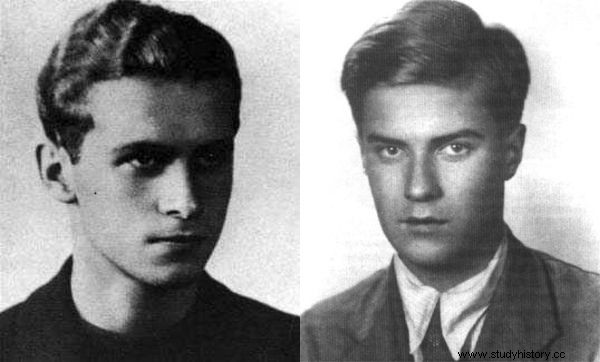
Cadet Krzysztof Kamil Baczyński (left) and second lieutenant of the infantry reserve Tadeusz Zawadzki (right). Source:public domain.
Zawadzki, in turn, graduated from a class with a mathematics and physics profile. He was multi-talented and established himself as a natural leader at an early age. Before his death, he managed to become a second lieutenant in the infantry reserve of the Home Army. His extraordinary beauty attracted attention, for which he was affectionately called by his friends "Zośka". Delicate complexion, regular features, light blue eyes and golden hair, a completely girlish smile - this is how Aleksander Kamiński, the author of "Stones for the Rampart" described him.

Jan Magura. Source:photo. Jan Magura senior, license CC-BY-3.0.
Also Jan Magura (1922-1944), a scout and a Home Army soldier with a captivating smile, unfortunately did not survive the war. In 1939, he graduated from the first year of high school. In the last days of August, he also became a glider pilot. This was his dream: after graduating from high school he wanted to study architecture and aircraft construction . However, it was not given to him. After one of the many sabotage actions in which he participated during the war, in January 1944 he was arrested. His twin, Stanisław, was also arrested with him. The trail of the brothers breaks off in the Krakow prison on Montelupich Street, where they were transported by the Gestapo.

Cadet Tadeusz Battek (left) and second lieutenant of the artillery reserve Karol Stanisław Dangel (right). Source:public domain.
Tadeusz Battek (1924-1943), pseudonym "Góral" and Karol Stanisław Dangel (1919-1943) joined the Home Army from scouting. During the war, Battek was a soldier of the "Osa" - Organization of Special Combat Actions. Dangel, a few years older than him, had been active in the Polish Secret Army since the fall of 1939, among others, together with Second Lieutenant Witold Pilecki. He also published in the underground… Melchior Wańkowicz's brochures. Neither of the two attractive scouts lived to see the victory over the Nazis. Both, although independently of each other, were arrested by the Gestapo in 1943, imprisoned in the Pawiak prison and shot. Dangel died on July 16 and Battek on September 17.

Captain Eugeniusz Stasiecki. Source:public domain.
Eugeniusz Stasiecki (1913-1944), even before the age of 30, proved to be a great teacher and scout instructor. He was a teacher by vocation - he gave lessons during the war, until the German authorities forbade him to do so. Later, he also conducted a course at the Gray Rank Infantry Reserve Officer Cadet School. He even managed to defend his Master's Degree in Pedagogy at the secret Polish University in 1944! However, his career was interrupted by death. He died in the Warsaw Uprising on August 16, 1944, just 12 days after the death of Krzysztof Baczyński. And the day after he himself was decorated with the Virtuti Militari V class cross …
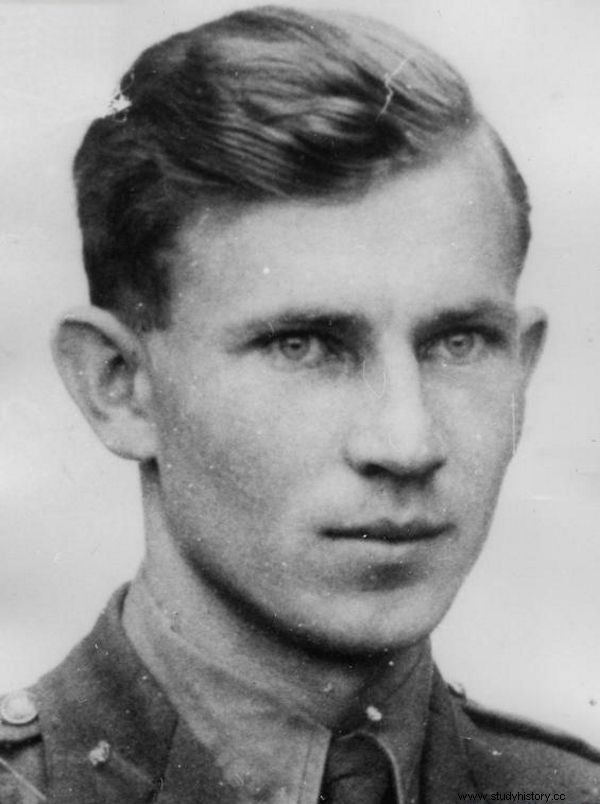
Captain Michał Fijałka. Source:public domain.
Another brave teacher, Michał Fijałka (1915-1983), was more fortunate than Stasiecki. After he fought in the September Campaign, he made his way through France to England. There he joined the Cichociemni and in September 1942 he returned to occupied Poland. He spent the entire war in uniform, fighting, among others, in Volhynia ... However, he survived and completed his pedagogical and agricultural studies in People's Poland. He worked as a teacher.

Lieutenant Alfred Zawadzki (left) and Lieutenant Roman Wiszniowski (right). Source:public domain.
The "paratroopers" were also Alfred Zawadzki (1912-1942) and Roman Wiszniowski (1920-1989). The first, certified officer, received the Virtuti Militari cross for the September campaign. He came to Great Britain, where groups of Cichociemni were formed, via Hungary and France. Looking at him, it's hard to believe that his friends nicknamed him "Pale" ...
The second, young volunteer soldier, before he was ordered by the Commander-in-Chief, General Władysław Sikorski, went through both German captivity and labor camps . He got out of the Soviet camp only thanks to the Sikorski-Majski pact. One of his pseudonyms in the conspiracy was "Joasia" - perhaps, as in the case of "Zośka", because of his beauty?
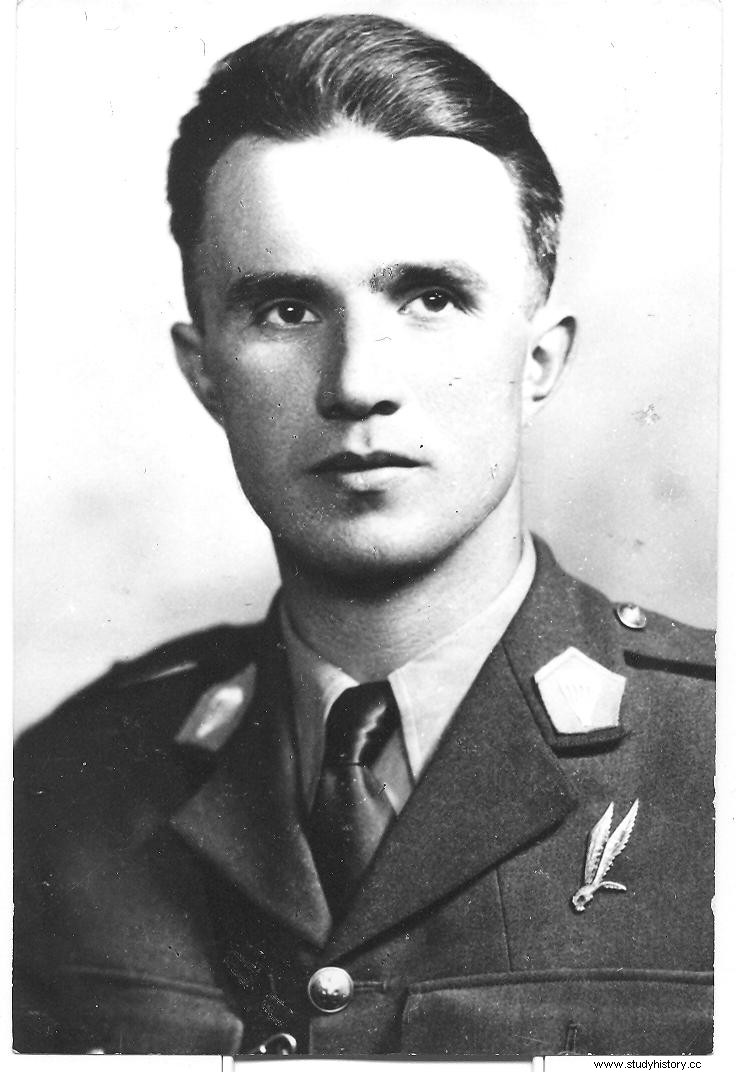
Infantry Major Adam Trybus. Photo Maciej Trybus, license CC BY-SA 3.0.
Infantry Major Adam Trybus (1909-1982) managed to finish his studies - classical philology - before the war. From 1937 he worked as a teacher. Like many others, he traveled half of Europe during the war. He also joined the elite group of cichociemni. Transferred to the country in October 1942, he fought in Poland until its liberation ... and even longer, because also after the end of hostilities, he did not lay down his arms. He was active in the anti-communist underground. He became an oppositionist for the rest of his life.

Lieutenant Wilhelm Pluta (left) and Second Lieutenant Władysław Wiśniewski (right). Source:public domain.
Wilhelm Pluta (1913-1986) and Władysław Wiśniewski (1915-1984), officers of the Polish Armed Forces in the West and the Home Army, although not without difficulty, made their lives in People's Poland. The former hid from the new Polish authorities until 1946! After the disclosure, he worked for a while on the radio, and then - already in the profession of a meter, learned before the war (he graduated from the Lviv Polytechnic University). Wiśniewski - another handsome and heroic teacher - conducted PE lessons in various schools in Kraków.

Captain Andrzej Prus-Bogusławski. Source:Public Domain.
Andrzej Prus-Bogusławski (1919-2006), Polish officer and Cichociemny, became a journalist after the war. Only then did he also finish his studies. However, he did not stay long in People's Poland - in 1981 he went to France, where he collaborated with, among others, "Kontakt" and "Kultura". He also took up World War II as a historian, writing books devoted to the fate of Polish units in Finland and Lithuania.
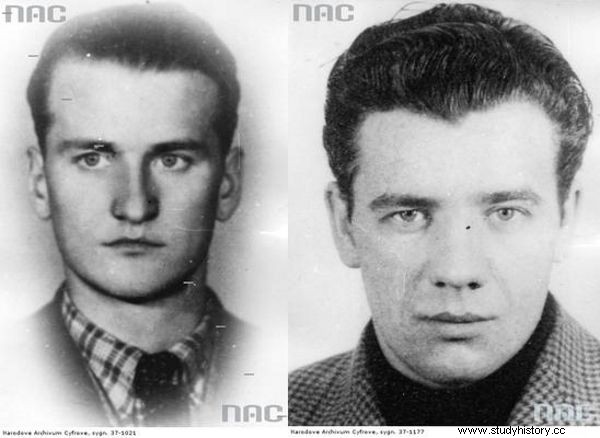
Captain Walery Krokay (left) and Second Lieutenant Władysław Śmietanko (right). Source:public domain.
Among the Cichociemni there were many handsome officers. The elite formation also included Walery Krokay (1914-1982) and Władysław Śmietanko (born 1920). Both of them were awarded the Silver Cross of the Order of Virtuti Militari for their wartime services. And they both emigrated to Great Britain after the war. Krokay (who lost his father and brother in the war, but had at least one brother and one sister) after fifteen years, in 1960, returned to the country. Here he lived to retire. Śmietanko remained in exile.
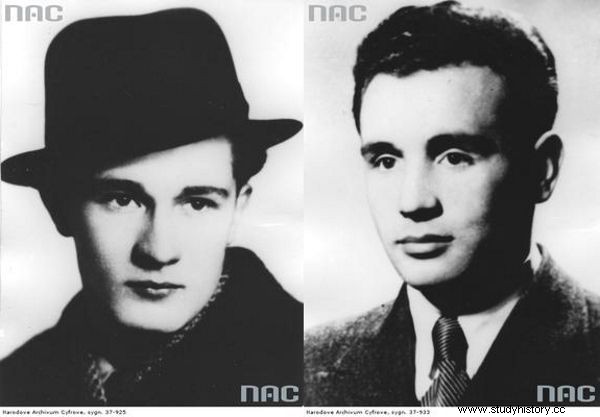
Second Lieutenant Ryszard Chmieloch (left) and Lieutenant Bronisław Czepczak (right). Source:Public Domain.
Ryszard Chmieloch (1921-1944?), Whose pseudonyms was "Bławatek", and Bronisław Czepczak (1922-2001), called "Zwijak 2", "Zebra 2" or ... "Bolek", were not mobilized in 1939 with because of his young age. Both and their families were deported deep into the USSR, where in 1942 they joined the Anders Army.
They returned to Poland, where they were dumped in 1943 and 1944 respectively, via Great Britain. But Bławatek was not lucky. In early 1944 he was captured by the Germans and sentenced to death. The exact date of execution of the sentence is unknown - the last news about him comes from April 1944.

Major Franciszek Malik. Source:public domain
Franciszek Malik (1912-2006), pseudonym "Piorun", chose a military career back in the times of the Second Polish Republic. The war found him already as a second lieutenant in the 2nd Podhale Rifle Regiment. After the September campaign, he was sent to a labor camp. He joined the ranks of the Polish Armed Forces only after the Polish-Soviet treaty of 1941. Before the end of the war, however, one more captivity awaited him - German ... After the liberation, however, the handsome officer did not return to Poland. He settled, like many others, disappointed with the post-war Polish reality, in Great Britain.
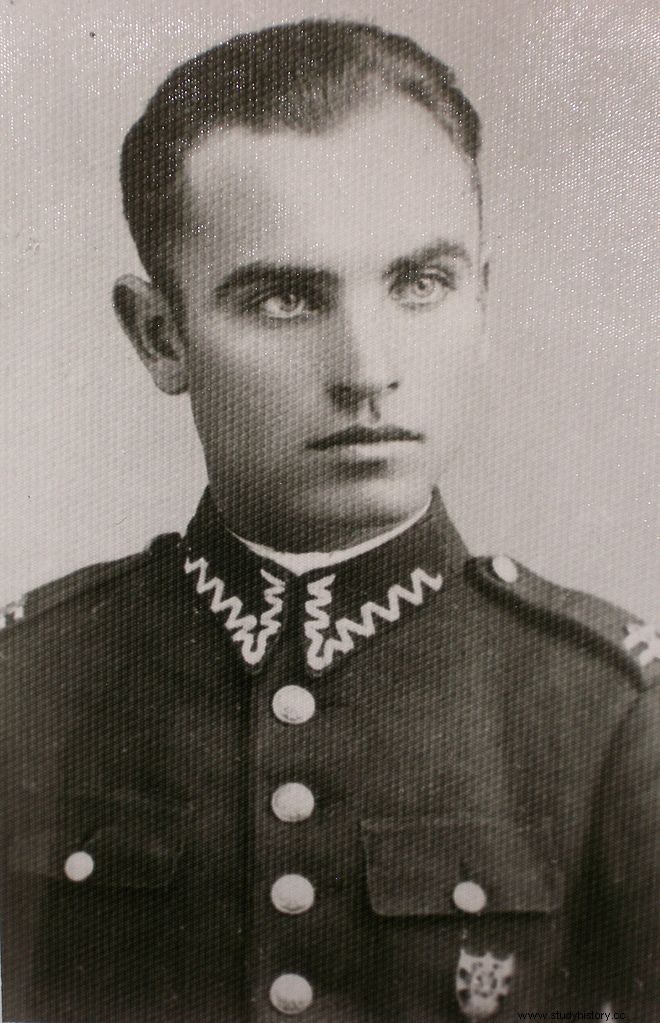
Captain Józef Kaczoruk. Source:public domain.
Before the war, Józef Kaczoruk (1915-1994) was also a professional military officer, a non-commissioned officer in the Border Protection Corps (and an extremely attractive one!). Like Malik, he was arrested by the Soviets and exiled into the USSR. However, he managed to escape and from 1940 he was active in the Union of Armed Struggle. After the war, he decided to stay in the country, but, especially before 1956, was repeatedly arrested by the security apparatus ...

Major Jan Kiwerski (left) and second lieutenant Kazimierz Kardaś (right). Source:public domain.
"Oliwa" and "Orkan" - these were the pseudonyms of Jan Kiwerski (1910-1944) and Kazimierz Kardaś (1919-1944). Kiwerski, a professional officer with makings of a great commander, found himself in Volhynia in 1944. He also died there, in circumstances that have not been explained to this day. Kardaś - a much younger member of the Gray Ranks - was an entrepreneurial activist in the Warsaw Assault Groups. He died as a result of wounds sustained during the unsuccessful attack on Walter Stamm, a high-ranking official of the German police in occupied Warsaw.

Lieutenant (?) Marian Przysiecki. Source:public domain.
The war found Marian Przysiecki (1905-1943) in the process of starting the family construction business. He has already graduated from universities in Poznań and Lviv. He had the opportunity to use his exceptional organizational talent also in the Union of Armed Struggle and the Home Army. He acted as part of the "Wachlarz" action, the purpose of which was primarily to organize a diversion on the supply routes of the German army attacking the USSR.
Przysiecki organized the base of "Wachlarz" in the area of Pinsk ... assuming the position of administrator of the Koby estate, about 30 kilometers from Pinsk. Arrested by the Germans in April 1943 in Warsaw (during a mass!), He was imprisoned by them in the Pawiak, tortured and finally shot.
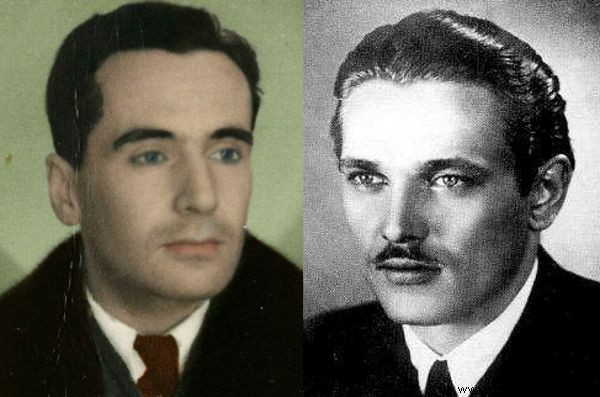
Colonel Kazimierz Leski (left) and Captain Henryk Flame (right). Source:public domain.
Kazimierz Leski (1912-2000) studied shipbuilding in the Netherlands before 1939. During the war, this engineer with the appearance of a movie lover was a pilot, and then ... became one of the Polish "musketeers" . The organization under this code name recreated the intelligence network broken up by the Germans in Poland. Leski also fought in the Warsaw Uprising. After the war, he first worked in the Gdańsk Shipyard, and then developed a scientific career at the Polish Academy of Sciences.
The pilot was also the extremely handsome Henryk Flame (1918-1947). In September 1939, however, he was shot down by the Russians, and later he was sent to a German POW camp. After he managed to get out of there, he organized the Polish Scout Home Army dealing with diversion. From 1943, he hid in the forests, first from the Germans, and then - when it turned out that he could also expect arrest from them - from the new Polish authorities. He did not appear until the amnesty of February 22, 1947. And a few months later he was murdered treacherously at the initiative of the communist authorities. From the judiciary, he was no longer in danger, so they found another way to get rid of him.

Jan Nowak-Jeziorański, "courier from Warsaw". Source:public domain.
"Kurier z Warszawy", or Jan Nowak-Jeziorański (1914-2005), climbed the ranks of his scientific career at the University of Poznań in the 1930s. He abandoned his unfinished doctoral thesis to take part in the September campaign. He only became an emissary of the Home Army to Polish authorities abroad, in 1943. In early 1944, he managed to get to England, where he spoke with representatives of the Polish and English governments, including Winston Churchill. However, he managed to return to Warsaw just before the outbreak of the uprising. Before it collapsed, he set off on another mission to London. And he remained in the West, reluctant to return to People's Poland. Soon he started managing the Polish Broadcasting Station of Radio Free Europe ...
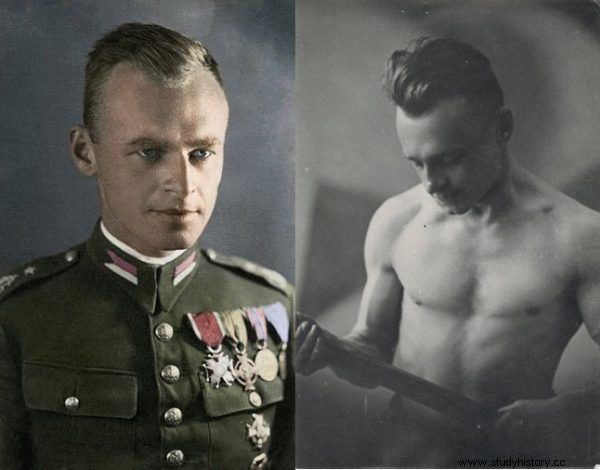
Captain Witold Pilecki. Source:Public Domain (left). The photo on the right comes from the book by Mirosław Krzyszkowski and Bogdan Wasztyl “Pilecki. In the footsteps of my father ”, published by Znak Horyzont publishing house in 2015.
Witold Pilecki (1901-1948) was ready for the greatest sacrifices. After the end of the September campaign, he co-organized the Secret Polish Army with Major Jan Włodarkiewicz. When part of the TAP leadership was captured by the Germans and sent to Auschwitz, the organization decided to send a representative to the camp, who would gather information about the conditions there and organize a resistance movement among the prisoners. It was Pilecki (possibly he even volunteered!).
He stayed in Auschwitz from September 1940 to April 1943, when he managed to escape . He risked his life more than once during the war (he also fought in the Warsaw Uprising), but he came out unscathed from every situation. However, he was not given a long life. In 1947, already in People's Poland, he was accused of a number of actions against the new authorities, including the preparation of an attack on the functionaries of the Ministry of Public Security. He was sentenced to death. The sentence was carried out in May 1948.
